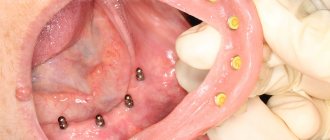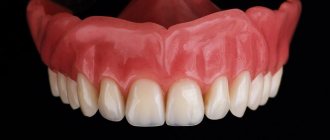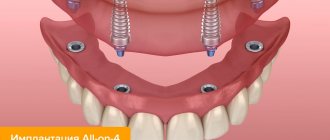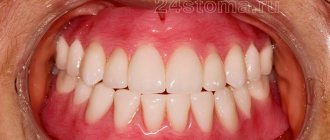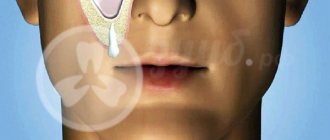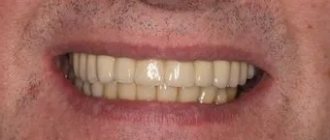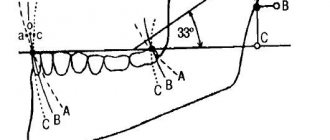Author of the article: Tsurkan Vladislav Gennadievich
Doctor-expert
Specialization: Dentist-orthopedist
Total work experience: since 2016
- Partially removable
Clasp
- QuattroTi
- Without sky
- Conditionally removable
- Which removable dentures are better?
With complete edentia
- With partial edentia
- For the upper jaw
- For the lower jaw
Restoring the dentition using removable dentures can be an alternative to fixed structures, especially when the latter have contraindications. To understand which type is suitable in your case, you need to know what removable dentures are available and how to choose the one that is best.
What types of removable dentures are there?
Removable dentures are classified according to the material of manufacture, method of attachment and indications. In addition, they are:
- completely removable;
- partially removable;
- conditionally removable.
These varieties can be used as permanent or temporary, for example, in preparation for implantation.
Fully removable
This option is equally good for cases of partial and complete edentia. Such an orthodontic appliance consists of a base (plastic, acrylic, metal-plastic or nylon) on which the teeth (acrylic, nylon or polyurethane) are located. Two types are considered popular and best among analogues (according to a number of characteristics):
- Acrylic.
- Acrylic-free.
Both of them have a number of features and indications that you should familiarize yourself with before choosing the best option.
Acrylic
They represent a complete or partial imitation of the dental system (depending on the number of missing units). Indicated for prosthetics of both jaws. Considered a budget option.
| Advantages | Flaws |
|
|
In addition, patients who have installed such orthodontic products are strictly prohibited from eating sticky and hard foods, as they can damage and render the prosthesis unusable. It is also worth knowing that acrylic is an excellent environment for the development of bacteria. Irregular or careless care of such dentures can lead to allergies or bacterial contamination. At night, acrylic dentures must be removed and stored in special solutions.
Acrylic-free (AcryFree)
AcryFree is innovative and superior to other full dentures. They are elastic and flexible, but at the same time durable and provide the necessary rigidity during operation. The manufacturing material used is acrylic resin, the quality characteristics of which are several times higher than medical nylon and plastic.
| Advantages | Flaws |
|
|
The main distinguishing feature is the translucency of the prosthesis base. The biocompatibility of the material ensures hypoallergenicity. In addition, high aesthetics makes AcryFree invisible to others.
Completely removable dentures are made taking into account all the physiology of the patient’s oral cavity (after taking impressions).
Partially removable
Partially removable dentures include those that require some effort to remove. You can remove them from the oral cavity yourself, but you need to know how the structure chosen for prosthetics works - how it is attached. This type of orthodontic appliances includes the following:
- clasp;
- QuattroTi (Quadrotti);
- without sky.
Each type has its own characteristics and requires a more detailed consideration.
Clasp
A classic version of conditionally schematic prostheses. There are four types:
- On clasps
. The most budget option. The design contains claw-shaped hooks. The main nuance that can be considered a disadvantage is the visibility of the fixing elements when smiling. Such orthodontic devices are chosen by those who do not care about high aesthetics. - Telescopic
. This type is characterized by the presence of two telescopic crowns - internal (metal, covering the supporting teeth) and external (made of metal-ceramics or plastic), attached to the prosthesis. The peculiarity of this type of prosthetics is the need for depulpation and turning of supporting units. - On attachments (locks)
. It consists of two parts, the first is on the tooth, the second is in the prosthesis. The parts of such an orthodontic apparatus are connected using special locks. The result looks very aesthetically pleasing. The main disadvantages are that installation requires depulpation and strong turning of the supporting units. - Splinting
. It solves two problems at once - restores the dentition and prevents loosening of movable units. The peculiarity of the fastening is a hook-shaped shape that completely follows the shape of the tooth. This option is better than others for patients with diseases such as periodontitis, gingivitis and periodontal disease.
The design of the clasp prosthesis itself consists of the following parts:
- metal arc (clasp), which is a support;
- base - a base that imitates gums on which artificial teeth are mounted;
- teeth (or crowns) made of metal ceramics, zirconium or ceramics;
- fastenings
An orthopedic dentist will tell you which partial removable dentures are best for you after collecting/studying the clinical picture and identifying possible contraindications.
QuattroTi
This is a type of clasp dentures, but modern dentistry distinguishes them separately as orthodontic devices of a new generation. The manufacturing material used is biocompatible Dental D plastic, which does not cause allergies. The design does not contain metal, has high strength and flexibility.
Other features include the following facts:
- imitates natural dentition as much as possible (manufacturing technology allows parts of the denture to be painted in different shades);
- installation does not require turning of support units;
- cheaper in cost than clasp analogues;
- does not rub the gums;
- does not affect diction;
- after fixation, no long adaptation period is required;
- the chewing load is distributed evenly.
With all the positive qualities, there is one caveat - the service life, even with proper use and care, is no more than 3-5 years.
Without sky
Invention of domestic specialists. The second name is sandwich dentures. Indicated for use in partially edentulous patients. The design consists of three parts:
- Base (made of acrylic).
- Artificial teeth (acrylic).
- Fastenings – clamps or telescopic crowns (made of polyurethane).
When installed, the clamps are pulled onto natural units and, due to the flexibility of polyurethane, fit tightly, holding the structure well. This type of prosthesis received the name “without palate” precisely because of the method of fixation. It is worth noting that these orthodontic products are better than their analogues in terms of their effect on healthy teeth - they do not deteriorate or become loose.
At the same time, there are several nuances that you need to be aware of:
- this option is not suitable for people allergic to acrylic and polyurethane;
- the use of this orthodontic apparatus does not allow the jaws to close completely (due to the thickness of the original material);
- most often the prosthesis is visible when speaking.
If aesthetics is not in the first place and there are no contraindications, then sandwich dentures will be an excellent solution for restoring lost units.
Conditionally removable
These include orthodontic appliances, which can only be removed by a dentist in a clinic (you cannot remove them from the oral cavity on your own). The most popular type is dentures on implants. Installation takes place in three stages:
- Preparing the oral cavity
. At this stage, thorough sanitation and treatment of problem areas is carried out. - Implantation
. As a rule, with complete edentia, 4 implants are sufficient to support the artificial jaw. After this stage, an adaptation period is required, which lasts until the gums are completely healed. - Installation of the prosthesis
. Special two-part clamps are used, which can be push-button or beam. The fasteners, clinging to the prosthesis, seem to snap into place, providing the most reliable fixation.
The technique is indicated for complete edentia, as the best way to restore the dentition. The service life of an orthopedic product depends on the choice of material and averages 10 years.
You might be interested in:
Removable dental prosthetics
New generation removable dentures
Conditionally removable prosthetics
Fixed dentures
Overdenture
Nylon dentures
Acrylic dentures
Denture “Butterfly”
Clasp prosthetics
Causes of loss of back teeth
The most common cases of loss of chewing teeth are neglected and untreated dental diseases: caries
, which developed into
pulpitis
or periodontitis, due to which the tooth had to be removed.
In addition, teeth (any teeth, including chewing ones) can fall out due to gum disease - periodontitis
or
periodontal disease
- in both diseases, the roots of the teeth become loose and do not hold in the inflamed gums.
Hormonal (for example, during pregnancy) or age-related changes also often lead to tooth loss.
Chewing teeth can also fall out due to prolonged wearing of bridges. When installed, such dentures are attached to adjacent teeth (most often to the posterior chewing teeth), and over a long period of wear they become loose. That is why bridge structures in modern dentistry are increasingly giving way to more advanced types of tooth replacement.
In the rarest cases, an end defect occurs in children at birth - when the rudiments of the back teeth were not formed at the stage of formation of the skeletal system. This happens mainly due to hereditary factors. You should also monitor your child’s primary chewing teeth – their premature loss can lead to the loss of the back molars.
One way or another, any lost tooth must be replaced as soon as possible, and the first step in this will be a timely visit to an orthopedic doctor.
On a note!
Currently, in As-Stom dentistry there is
a 15% discount
on all dentures and
a 50% discount
on an implant with installation. Both dentures and implants are excellent options for replacing lost back teeth.
Which removable dentures are better?
It is impossible to choose one option that will be better for all cases without exception. The preferred options should be chosen based on the needs and the current clinical picture. Most often, patients are interested in which removable dentures are better:
- with complete edentia;
- with partial edentia;
- for the upper jaw;
- for the lower jaw.
By studying the opinions of orthopedic dentists outlined below, you are guaranteed to be able to make the right choice in favor of the removable denture that will be best for you.
With complete edentia
The problem of complete absence of teeth is solved by two types of removable dentures:
- On implants
. They perfectly restore chewing function and provide reliable fixation. They guarantee a uniform load, which is very important to prevent bone resorption. There is only one drawback – the high cost of the product and the dentist’s work. - On suction cups
. They are presented in a variety of materials and are individually selected for each patient. Such dentures can be removed at night, giving the gums the opportunity to rest and “breathe.” The main advantage is the affordable cost.
In case of complete edentia, it is better to refuse to restore the dentition with nylon dentures. They do not allow you to chew solid food fully and comfortably, which is extremely inconvenient. In addition, they do not have a very strong suction ability, so the risk of spontaneous loss increases.
With partial edentia
If all teeth are lost, dentists recommend one of two options:
- Clasp dentures
. Relatively expensive, but most effectively imitate natural teeth. Reliable fastening ensures that spontaneous falling out will not occur. The design allows you to evenly distribute the chewing load. - Acrylic
. A more budget option, represented by a variety of prosthetic models. Only an orthopedic dentist can choose the ones that are right for you.
If implantation is planned and temporary and inexpensive restoration of the dentition is necessary, a butterfly denture can be used.
For the upper jaw
Compared to the lower jaw, the upper jaw is much better suited for prosthetics. The reasons for this are the vast palate, which allows for better fastening of orthopedic structures. For both partial and complete edentia, any type of removable denture can be used on the upper jaw, for which there are no contraindications.
For the lower jaw
When using lower jaw prosthetics, less effective fixation is noted because:
- small sublingual space;
- tongue movements increase the risk of slippage of most types of removable orthopedic structures.
In view of these nuances, two types of dentures are recommended as the best and most reliable orthopedic structures for the lower jaw - clasp and implant-based.
What to choose?
When preparing for full dental prosthetics, it is necessary to consider the pros and cons of different models of dentures and take into account the following factors:
- convenience . Removable appliances must be removed periodically. Dentures are located on the surface of the gums, which makes hygiene measures difficult;
- number of lost teeth . If the number of missing teeth is 1-2, a conditionally removable mechanism, crown or implant can be installed;
- result of prosthetics . Fixed devices are better than removable ones at regenerating the chewing function; veneers and implants are the most effective at restoring facial aesthetics;
- cost of treatment . Budget prosthetics - plastic restorations, solid metal crowns. Higher prices are for artificial roots and clasp systems.
You can choose the type of prosthetics and restoration during a consultation with our specialists. During a visit to the dentist, an experienced orthopedic doctor will diagnose the teeth, draw up a clinical picture, study individual contraindications, inform about the materials used, restoration methods, and the timing of the production of the prosthesis in our laboratory. From the widest selection, it will offer the best option in terms of quality and price. We care about our patients, so we offer treatment at a low cost in dentistry in the Eastern Administrative District of Moscow
Read also
What are clasp dentures for teeth and which ones are better?
Dental restoration using clasp dentures is one of the most popular and budget methods.
Who is an orthopedic dentist?
Orthopedics in dentistry is a branch of medicine that deals with the restoration of teeth using all modern prosthetic techniques.
Post-treatment care
After installation of orthodontic dental prosthetic systems, careful oral hygiene is necessary. The presence of fixed/removable appliances increases the risk of developing diseases and inflammatory processes in the mucous membrane and living periodontal tissues. Hygiene includes caring for the tongue, gums, remaining teeth, and artificial structures. Doctors recommend cleaning 2-3 times a day after meals to prevent the formation of plaque and deposits and ensure fresh breath.
It is recommended to remove removable structures, clean them with a stiff brush, rinse them for 1-2 minutes with running water, and disinfect them overnight by immersing them in an antiseptic solution. Implants and fixed dentures do not require special cleaning methods; their care is similar to the care of natural units. Hygienic procedures after dental prosthetics should be carried out using prophylactic pastes, threads, irrigators, elixirs, and rinses. The need for proper oral care will help maintain healthy bone tissue, avoid the risk of gum injury and increase the service life of dental restorations.
Expert advice
There is no clear answer to the question of which prosthesis to choose in a given case. The structural features of the patient’s jaw apparatus, his age, and the severity of the problem are of great importance. Approximate recommendations are given in the table:
| Situation | Type of prosthetics |
| Clinical picture | Recommended type of prosthetics |
| Availability of dental units suitable for fastening the structure | Conditionally removable prosthesis |
| The dentition lacks a large number of dental units, and the installation of bridge-like structures or implantation is impossible | Removable prosthetics |
| Molars or incisors are completely absent from the dentition | Removable prosthetics. It is recommended to choose acrylic dentures |
| Molars and premolars are missing | Partially removable prosthetics |
| Requires installation of temporary prostheses | Partially removable prosthetics |
General characteristics
The popularity of titanium crowns is determined by several factors.
Firstly, the properties of the material guarantee its biological compatibility and the absence of allergic reactions in the patient’s body. Rejection of dentures is extremely unlikely.
Secondly, titanium makes it possible to create replacement elements that provide various functions - supporting, protective, restorative and aesthetic. The effectiveness of use is confirmed by statistics - today most of the various crowns, implants and prostheses, both removable and permanent, are made from this metal.
